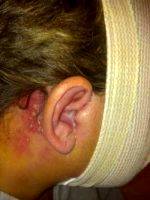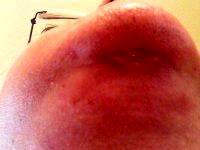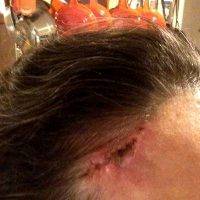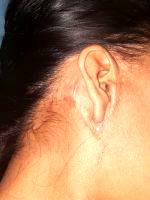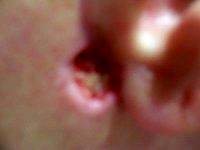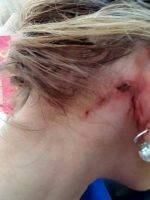Facelifts Gone Bad
Facelifts gone bad are the possible complications after a facelift. In most cases, complications in performing facial rejuvenation procedures may be related to the quality of bleeding stopping, the accuracy of tissue separation, and the maintenance of sufficient blood supply to skin flaps.
After facelift, the following complications are possible:
Hematoma. The presence of a hematoma is indicated by pain, leakage of blood in the area of sutures, an increase in the volume of tissues to the front of the ears and in the region behind the ears (often only on one side). Hematoma is diagnosed during the observation of the patient for 4-6 hours after tightening the skin of the face.
With late diagnosis of complications, necrosis of the skin flap may develop, which threatens with serious consequences.
Small hematomas can be removed through the seam line, or by aspiration. In the case of an increasing or intense hematoma, the patient is urgently taken to the operating room. The surgeon opens the wound, removes clots of blood and stops the source of bleeding.
Prevention of hematomas begins during the preparation for the operation. Immediately before the facelift, the patient undergoes a complete clinical examination.
Necrosis of the skin. The complication arises from the insufficient supply of the skin flap, the reason for this is its thinning, too much detachment of the tissues, and also the tension on the seam line. Necrosis of the skin more often develops in the behind-eye area, where there is a line of the greatest tension of tissues.
Suppuration of wound. This complication develops rarely, and often because of unsuccessful hematoma or tissue necrosis. Suppuration can occur due to the ingress of hair into the wound during the application of sutures in the scalp.
Hypertrophic scars. Hypertrophic scars are formed rarely, often in the behind-eye area and may be accompanied by pain. They arise, as a rule, due to tension on the seam line, as well as due to an individual tendency to form scars. To prevent hypertrophy of the scars can be by changing the configuration of the seam.
Pigmented spots on the skin. Pigmentation occurs more often with intradermal hemorrhage in people with sensitive skin. During the year, as a rule, the pigmented spots completely disappear.
The deformation of facial contours. After the facelift, local changes in the contours are possible, the cause of which is the occurrence of small hematomas and / or the movement of skin flaps, cut out within the superficial muscular-fascial system.
The more pronounced deformations of the facial contours are often the result of inaccurate intersection of the cervical muscles of the neck, excessive removal of fat deposits in the chin area, uneven liposuction.
Reduce the likelihood of deformation of the contours of the face can be achieved by careful planning procedure Facelift, as well as the precise technique of the work of a plastic surgeon.
Hair loss (local, generalized). With a local form, hair falls out behind the ear and temporal areas due to the formation of very thin skin flaps, due to damage to the layer in which the hair follicles are located. Lost hair is often restored within 3 months, otherwise the problem is solved operatively. In generalized form, the main cause of hair loss is the transferred stress. More often it affects women who had weakness of hair bulbs before the face lift procedure, and a tendency to hair loss was revealed. At the planning stage of the operation, such moments are usually discussed in detail with the patient.
Many people want to keep their beauty and youth to an advanced age. And if not the whole body, then at least your face. And if earlier it was possible only under condition of observance of a healthy way of life (and that not always), now many are seduced by miracles of plastic surgery. One of the most popular areas of this industry is a face lift.
The essence of this plastic surgery is known to many – by removing excess skin and fatty tissue on the parotid part of the head, the remaining skin is sewn onto a new, higher place. Due to this, the skin of the front face surface is stretched, making wrinkles and other age changes less noticeable. But, despite the popularity of this procedure, its side effect, complications and consequences remain in the shade.
One of the earliest dangers of the facelift surgery is the consequences of any surgical intervention accompanied by general anesthesia. Failure to comply with the right diet, at least one day before the operation, any person at risk of provoking aspiration pneumonia, which will be treated much longer consequences of the operation itself.
In addition, often a person decides to have facelift surgery at a fairly old age, which can often be the cause of complications from anesthesia. Since facelift is not a vital procedure, it is always worth considering, and it is this operation really necessary?
In addition to the most general warnings from facelift, there are other, more specific consequences and complications of this operation. Traditionally they are divided into early and late.
If the first type of complications often arises through the fault of the surgeon and often their free removal (if you use the services of a really good and conscientious clinic) is immediately described as part of the contract, then the long-term effects of facelift appear only because of the characteristics of the human body that underwent this procedure. The early complications include: postoperative hematomas, skin necrosis, lymphatic edema of tissues, infection of tissues as a result of surgery.
By late often include the violation of sensory and motor innervation of the facial skin, hypertrophic scar on the site of the operating wound, facial asymmetry, hyperpigmentation of the skin and hair loss (alopecia).
Hematoma after facelift procedure occurs, usually in the first hours after surgery and is characterized by a sharp swelling of the facial tissue, bleeding through the surgical sutures, sometimes with weakness and dizziness.This complication occurs as a result of damage to one of the arteries, which was not sewn up or burned during facelift surgery. This complication requires urgent repeated surgery in order to find and bind a bleeding vessel.
Necrosis of the skin, especially in the area of the sutures, often accompanies many surgical interventions in patients with diabetes or atherosclerosis.
Therefore, such persons should be carefully informed before the procedure of facelift about possible consequences and complications of the operation.
Lymphatic swelling of the tissues, although it refers to early postoperative complications after facelift, but most often arises because of the peculiarities of the structure of the organism of the operated person, and not because of the sluggishness of the surgeon. Such swelling occurs due to overlapping of several lymph ducts, which are known, characterized by a wide variability.
Unlike such swelling, infection of tissues during the facelift procedure arises only through the fault of the surgeon or the medical personnel.
Postoperative infection is characterized by a significant increase in body temperature, the presence of pronounced redness and swelling around the postoperative suture, in later stages – with the release of pus. This condition after surgery requires the immediate use of antibiotics.Violation of the innervation of the skin is a characteristic side effect after facelift, but if they do not disappear within two weeks after the operation, this indicates damage to large nerve trunks, the restoration of which can take several years.
Violation of motor innervation of facial muscles can lead to asymmetry in the face contour, and such effects of facelift are almost impossible to correct even by repeated operation.
Hypertrophic scar arises from the increased ability of the body to recover. It is the most frequent negative consequence of facelift procedure.
Pigmented spots and hair loss are also entirely dependent on the state of the body during the operation.
Thus, a simple facelift surgery is fraught with many dangers, so you need to listen to more than one plastic surgeon (who has one goal – to convince a person of the need for an operation) before the operation, and the opinions of many specialists on this issue, then the appearance of complications after facelift will be equal to zero.
Facelift Gone Wrong Photos
- Bad Face Lift Photo
- Bad Incision
- Bad Rhytidectomy Scar
- Bad Scar After Facelift
- Bad Scar And Wound
- Bad Scar
- Bad Surgery Facelift
- Bad Surgery Scar
- Bad Swelling After Facelift
- Behind The Ear
- Big Hematoma Face
- Bleeding After Surgery
- Bleeding
- Blister
- Blood
- Complication Behind The Ear
- Complication Photo
- Complications Following Facelift Surgery
- Complications Following Rhytidectomy
- Damage To The Facial Nerve
- Day 16 For Burn
- Evere Infections
- Face Lift Complication Gone Bad
- Face Lift Complication Photo
- Face Lift Risk
- Face Lift Swelling
- Facelift Bad Result
- Facelift Bad Scar
- Facelift Bad
- Facelift Gone Bad Image
- Facelift Gone Wrong Photo
- Facelift Gone Wrong Pictures
- Facelift Risks And Complications
- Facelift Risks Photo
- Facelift Scar Complication
- Facelift Scar Risks
- Facelift Surgery Gone Wrong
- Faceligh Gone Wrong Before And After
- Facial Plastic Surgery Bad Results
- Gaping Of The Wound
- Gaping Stitches
- Gaping
- Gone Bad Behind The Ear
- Gone Bad
- Gone Wrong Behind The Ear
- Gone Wrong Infection
- Gone Wrong
- Hair Loss After Facelift
- Health Risks After Facelift
- Health Risks After Plastic Surgery For Face
- Hematoma After Surgery
- Hematoma And Swerlling Of Face
- Hematoma Bruise
- Hematoma Bruises
- Hematoma Complications
- Hematoma Neck
- Hematoma
- Hypertrophic Scarring
- Incision Gone Bad
- Incision Gone Wrong
- Infection After Facelift
- Infection After Rhytidectomy
- Infection
- Keloid
- Loss Of Hair
- Loss Of Skin From Tissue Death
- Lot Of Pain On Face
- Major Hematoma
- Mini Facelift Gone Wrong
- Pain After Facelift
- Pain
- Photo Of Hematoma
- Plastic Surgery For Face Infection
- Plastic Surgery For Face Necrosis
- Plastic Surgery On Face Scar Infection
- Redness After Facelift
- Rhytidecomy Hematoma
- Rhytidectomy Bad Results
- Rhytidectomy Gone Bad
- Rhytidectomy Infection Picture
- Risks – Complications Photos
- Scar Gone Wrong
- Scar Infection Picture
- Scar Infection
- Sensory Impairment
- Serious Infection
- Skin Discolouration
- Skin Flap Necrosis
- Skin Necrosis Facelift
- Skin Necrosis Photo
- Skin Necrosis Rhytedectomy
- Skin Necrosis
- Skin Slough
- Surgery Gone Bad
- Surgery Gone Wrong Pictures
- Surgical Facelift Complication
- Swelling After Facelift
- Swelling After Rhytidectomy
- Swelling
- Thickened Scar
- Unrecognized Hematomas Can Lead To Skin Necrosis
- Unsightly Scar Formation
















